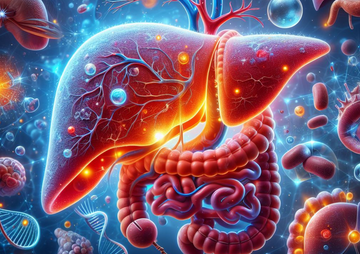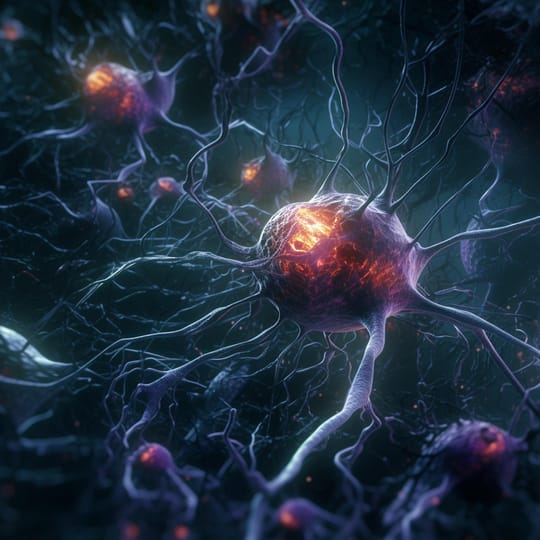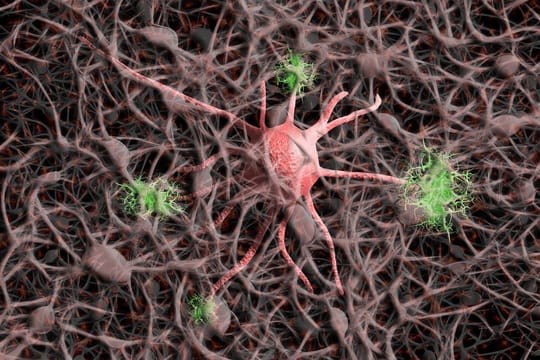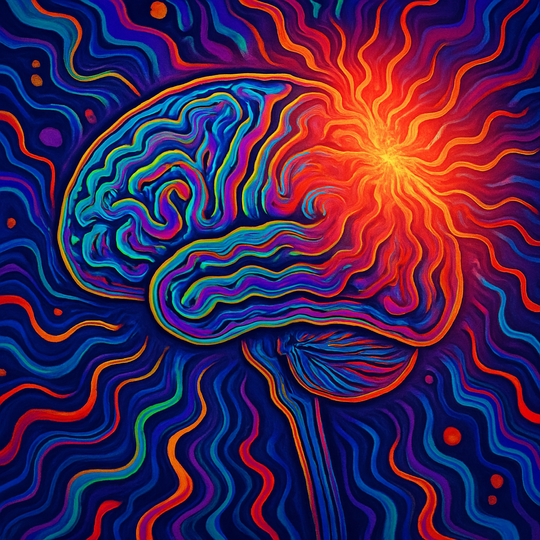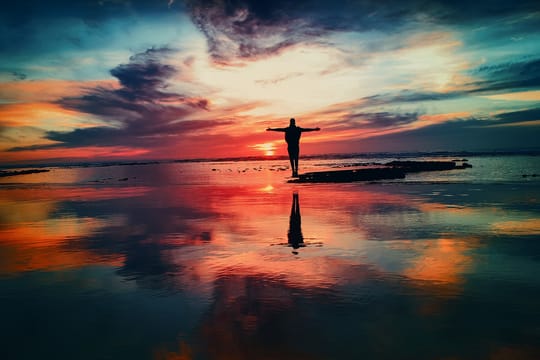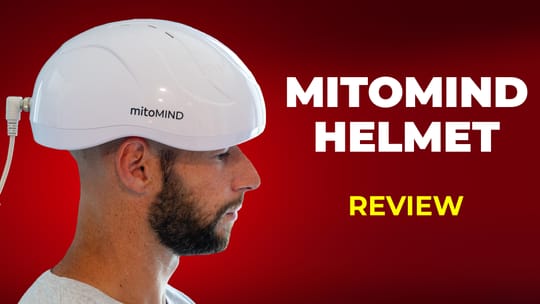A stroke can shatter a life in an instant. I've seen this happen to people around me–fortunately, not close family, but still!
One moment, you may be laughing, speaking, and moving; the next, you're trapped inside a body that won’t respond like it used to. The worst part? Your family is often helpless in aiding your full recovery. And then the issues come to light, such as problems with movement, speaking, thinking, and much more. You'll fondly remember your previous life and often do anything to get that life back.
As a physical therapist, I also worked an internship in the neurological department of a hospital. I saw patients and had to assess their health, movement ability, ability to talk, and so forth, often quite quickly after a stroke had happened.
Then, as a young 23-year-old, I needed to have difficult conversations with the family that I wasn't prepared to make at that age. That scene is 15 years ago now, but I remember it like it was yesterday! So, I know a thing or two about strokes. Strokes can be a horror movie that you cannot turn off.
But there's some hope, though!
Red light therapy...
Red light therapy is a gentle, non-invasive treatment and may aid stroke recovery. I'll cover all of the human science published on red light therapy for stroke in this article.
Here's the deal: If you're short on time, simply read the attached summary below. That summary provides a solid foundation for understanding what to do in this case. This is not medical advice, however, and before ever applying red light therapy after a stroke, talk to your medical doctor! If you wish to understand my full argument, however, you'll need to read this entire article, where I delve into great detail on the science.
Let's go:
I consider red light therapy for stroke here today. Unfortunately, there isn't much high-quality human evidence to support recommending this therapy universally. Some case studies (which don't have a high evidence base in medicine) show extremely promising outcomes.
For your background, strokes form after a blood vessel in the brain is blocked or ruptures. The location, in part, determines the symptoms. The result is brain damage, and often some of that brain damage is permanent--which strongly depends on early treatment.
About a dozen or two risk factors exist, such as age, hypertension, being overweight or obese, smoking, air pollution, heart and blood vessel problems, diabetes, and more. Most of these risk factors are under your control, making most strokes preventable. New technologies and emerging therapies are making strokes more treatable, and this trend is likely to continue.
Red light therapy can affect stroke recovery through many biological mechanisms; however, more research is needed to investigate the topic. Examples include improved mitochondrial function, enhanced blood flow, reduced inflammation, increased production of brain-derived neurotrophic factor (which aids in creating new brain cells and connections), detoxification via the glymphatic system, and repair mechanisms facilitated by stem and glial cells.
Nevertheless, the 10+ human studies in existence on red light therapy for strokes are generally very positive, with some showing life-changing effects. Consult your doctor if you wish to initiate treatment here. Throughout the document, I provide guidance on key considerations for treatment.
If you need an introduction to what these terms mean, check the following resources:
- What Is Red Light Therapy?
- Red Light Therapy Explained: Basic Terms Guide
- Start Here - Light Therapy 101 & Buyers Guide
- Red Light Therapy Dosing Chart: The Raw Data From Hundreds Of Studies
- Red Light Therapy Dosing: Why It's Complicated!
- Red Light Therapy Wavelengths Benefits: The Ultimate Guide
- How Often Should You Use Red Light Therapy Explained
These resources should give you a basic understanding of how red light therapy works, and the discussions around it!
Stroke Basics: The Science
Let's examine the latest scientific research on strokes. I'll only consider so-called "reviews" here, which analyze and integrate earlier evidence on a given topic.
But basics first:
What Is A Stroke?
What is a stroke?
During a stroke, blood flow to part of your brain is either fully interrupted or reduced. As a result, that brain area receives less oxygen and nutrients. Damage is the result, unfortunately.
There are two main stroke causes:
- Ischemic stroke: Caused by a blockage of blood vessels, such as a clot; ischemic strokes account for approximately 85% of strokes.
- Hemorrhagic stroke: Caused by bleeding in the brain.
As you can imagine, if parts of your brain suddenly aren't working, symptoms result. The symptoms you get depend on the area of the stroke, however.
If you have a stroke at your brainstem, the oldest evolutionary part of the brain, you'll have many basic life functions, and eye movement, swallowing, etc, affected. In severe cases, you may not be able to move. In the frontal lobe, however, where the prefrontal cortex is located - the "CEO of your brain" - decision-making and personality will be more heavily affected.
After a stroke, the brain tries to recover. Using your brain (and body) heavily is paramount there, as the early period directly after a stroke is most important for recovery. Over time, the ability to heal becomes lower.
So let's consider why you end up with a stroke in the first place:
How Strokes Happen: Risk Factors
Many stroke risk factors exist, and many of these are within your control, fortunately!
Here are the main stroke risk factors (1: 2; 3; 4: 5; 6; 7; 8):
- Age - the older you get, the higher your stroke risk becomes.
- Female sex - unfortunately the women have slightly increased stroke risk!
- Having other chronic health conditions in general - this is a little bit self-explanatory, but if you've got chronic conditions, it's a sign your health has already deteriorated.
- Hypertension - and heart disease in general. Makes sense, as blood clots and bleeding are "heart and blood vessel" diseases technically!
- Atrial fibrillation (AF) - an irregularity of the heartbeats that's problematic, such as the skipping of heartbeats in their entirety. AF causes a 3 - 5X risk increase alone (8)!
- Being overweight or obese - the best way to lower your risk is to normalize your waist circumference.
- Diabetes - this is one of the best-defined risk factors!
- Smoking - a simple but not an easy one to correct for many!
- Excessive alcohol use - I do not believe that not drinking at all is best - if you can drink moderately, with a few glasses per week, overall mortality is lowest. Check Dr. Chris Masterjohn's work on alcohol if you're curious! The problem here is, most people cannot stick to a half to one glass per day, in the same way they cannot just smoke one cigarette per day!
- Air pollutants are responsible for 14% of worldwide strokes (3). Consider getting an air purifier if you live in a polluted city.
- Living at a very high altitude (10,000+ feet)
- Gut dysbiosis
- Systemic infections
- Sleep apnea - A very complex topic, many people need their airways fixed due to dysformations in that area, because of improper jaw development. I write about that topic in my photobiomodulation in dentistry article.
- Familiar history (genetics).
Identifying A Stroke
A stroke has sudden emergence of symptoms. Because, the blockage of the blood vessels or the bleeding starts at one very particular moment.
Here are some of the most common symptoms:
- Being weak or numb (usually at one side of the body)
- Having difficulty speaking
- Vision loss
- Confusion or trouble understanding
- Severe headache (more common in hemorrhagic stroke)
- Loss of coordination or balance
- Changes in facial expression (often there's less or no tension at one side of the face.
If you see any of the symptoms in your loved ones or a stranger, especially multiple of them, call an ambulance!
During the doctor's visit or the ambulance ride, specific medications can be administered (9; 11). There's also identification, such as CT and MRI scans, to differentiate between strokes, and then heart and blood vessel testing and more. You'll receive specific drugs to lessen the effects of the stroke.
Brain Recovery 101 & Long-Term Consequences
Then the long-term rehabilitation starts (10). Examples here are physical therapy that starts almost immediately (which I performed), speech therapy to learn to talk again properly, cognitive rehabilitation because parts of your thinking may be impaired, and more. You'll also want to avoid recurring strokes at all costs, which are between 5 - 50% (12).
Often, strokes have long-term consequences. Here's what a recent review writes about that dynamic:
"One of the most clinically relevant aspects of the chronic sequelae of stroke is its extended negative effect on cognition. Cognitive impairment may be related to the deterioration and dysfunctional reorganization of white matter seen at later timepoints after stroke, as well as ongoing progressive neurodegeneration. The vasculature of the brain also undergoes significant insult and remodeling following stroke, undergoing changes which may further contribute to chronic stroke pathology. While inflammation and the immune response are well established drivers of acute stroke pathology, the chronicity and functional role of innate and adaptive immune responses in the post-ischemic brain and in the peripheral environment remain largely uncharacterized." (13)
Depression is also a widespread side effect - for a good reason (14)! Nevertheless, there are also bright developments. AI is transforming stroke management, for instance (15). Many other therapies are also expanding, including diagnosis, medication, and more!
And, there's a promising effect of red light therapy - a topic I'll explore in a second. First, let's consider brain light therapy's impact on the brain in general:
Red Light And Brain Healing Science
I've written a lot on red light therapy and brain health. These are:
- Red Light Therapy For Upgrading Your Brain Health
- Red Light Therapy For Parkinson's Disease: A Hopeful Strategy!
- Red Light Therapy For Epilepsy: Current Science Explained
- Red Light Therapy For Fibromyalgia: Incredible Pain Relief & Much More!
- Red Light Therapy For Sleep: The Science of Sweet Dreams
- Red Light Therapy For Neuropathy: The Promising Science
- Red Light Therapy For Migraines 101: Why The Research Is Super Promising!
- Red Light Therapy For Depression: A Potential Solution
- Red Light Therapy For Traumatic Brain Injury Science: Speed Up Recovery Significantly!
- Everything You Need To Know About Tinnitus & Red Light Therapy
So, the question is, what does red light do for your brain? There are numerous fundamental mechanisms at play. Over 500 studies on red light therapy for brain health have been published to date (16; 17; 18; 19; 20). Nevertheless, there are tons and tons of discussions about the exact mechanisms by which the brain is affected.
I'll mention a few of these below:
- A boost in mitochondrial function and energy production. Generally, an increase "Adenosine-Triphosphate (ATP)" is held responsible for this effect, but some fringe scientists disagree. An increase in mitochondrial function, through several mechanisms, is generally postulated, though!
- Better brain blood flow. This one is self-explanatory!
- Lower inflammation and oxidative stress. Both are intertwined and damaging in excess. Chronic inflammation is a sign of chronic disease.
- Helping your brain create "Brain-Derived Neurotrophic Factor" or BDNF, which helps create new brain cells and connections (synapses). BDNF may be essential for strokes!
- Better detox. The "glymphatic system" - a detoxification system of the brain - has gained significant attention in the last decade following its discovery. The glymphatic system is closely intertwined with sleep quality.
- Boosting brain repair. Stem cells and glial cells are the primary compounds here that help increase repair mechanisms - again, super important for strokes!
Next up, below, I'll finally venture into the topic of this article - red light therapy for stroke recovery:
Red Light Therapy For Stroke Recovery: A New Light On Rehabilitation?
I'll only consider the human studies here. I've used Vladimir Heiskanen's wonderful Excel sheet that contains 8,000+ studies once again (28).
There's been tons and tons of animal research published on this topic as well, but it's not always applicable to humans. The reason is that the brain of animals works really differently from that of humans. Additionally, the skulls of rats and mice are entirely different (much thinner), making it more challenging to extrapolate data from animals to humans.
So here's my breakdown of 10+ studies on red light therapy for stroke recovery:
- First, there's a case study of a 38-year-old woman who received an ischemic stroke (21). "Transcranial photobiomodulation" or "red light therapy through the skull was applied at different locations, at 250 mW/cm2 for a 12 J/cm2 dose. This is actually a "torch" device that's similar to what some other red light therapy companies offer on the market (22). This approach was paired with an 810 nm LED helmet for 28.8 J/cm2 over 20 minutes. The woman hadn't improved for 5 months of speech there. Then the light therapy was applied. Here's the outcome:
"During the initial, 5-month treatment series with traditional speech-language therapy only, there was little to no improvement in [problems speaking] and expressive language. During the second, 5-month treatment series, however, with [red light therapy through the skull] applied first, to the left hemisphere only, and second, to both hemispheres during each session plus simultaneous speech-language therapy, there was marked improvement in the dysarthria and expressive language. After the first 5-month series, this [person with aphasia - or trouble speaking] had utilized a slow rate of speech with a production of ∼25 to 30 words-per-minute during conversations and spontaneous speech. Utterance length was only 4-6 words with simple, grammatical structure. After the second, 5-month series of treatment combining tPBM plus speech-language therapy, the rate of speech increased to 80+ words-per-minute and utterance length was increased to 9-10 words, with more complex grammatical structure." (21).
- So, even though the woman was already in a later phase, in which less recovery could be assumed, adding the light therapy did create huge gains in her speech ability. So the speaking ability of words tripled and the sentences she could complete doubled, which is fantastic!
- The second study shows that a combination of red light therapy through the skull and electrostimulation that moves muscles ("NMES") is a good combination after stroke:
"Our clinical trial showed improvement of cognitive function, pain relief, greater manual dexterity, enhancement of physical and social-emotional health which lead to better quality of life and well-being. There was also increased temperature in the treated regions with laser and NMES. " (23).
- Then, a retrospective study - so it's not a true clinical trial with a randomized control and intervention group - with 34 participants (24). Here, laser irradiation of the blood was used, where the blood is directly treated with light, at 632 nm. Disability and dependence went down in the light therapy-treated, group.
- A 640, 875, and 905 nm study applied to the lower limbs didn't find any significant effect (25). Figure 1 shows the treatment area (26):

- Different doses were used in this study but it was a single-session light therapy application. Magnetic fields were also applied, making the outcome a bit useless to be honest.
- The next study also combined red light therapy and static magnetic fields (27). Wavelengths used are 640, 875, and 905 nm. This study did have the proper setup with placebo and intervention groups. Different doses were used again (it's the same research group). Functional capacity, such as walking and getting up from the chair, improved in the group receiving the light therapy.
- Additionally, a study at 633 and 870 nm was applied to the brain and skull (29). The study participants also received a functional MRI that tracks developments in real time. The study shows that the light penetrates the skull, and researchers write:
"[Near infrared] photons can affect surface brain cortex areas subjacent to where LEDs are applied on the scalp. Improved naming ability was present with [one of our protocols]. [Red light therapy applied through the skull] may be an additional noninvasive therapy for stroke."(29).
- Surprisingly, there are some older studies, such as the one I'm discussing now, from 2014 that don't show any outcome (30). The study was terminated because no effect was found. A huge number of 630 participants were included here.
- The same is true for another older study - no effect found (31). The full texts of the studies don't supply a lot or even no info on how the treatment was applied, unfortunately (32; 33).
- One more case report (with 1 participant) shows that 660 and 850 nm, used over 8 weeks, has a "dramatic effect" with a repurposed Thor laser device, it seems (34). Here's the outcome:
" The patient was seen once a week for 8 weeks and treatment sessions lasted approximately 60 min. The results were dramatic: after 8 weeks of implementation of our protocol, the patient demonstrated positive change in every area of her deficits as determined by improvements in physical examination findings. The gains achieved at 8 weeks have been maintained to this day and she continues to be treated once every 4 weeks." (34)
- The treatment protocol is quite complex, targeting multiple areas of the body (35). Figures 1 and 2 effectively describe this protocol (35). If you're curious, here are the full effects described in the article (35):

- So, that's a huge improvement in overall health!
Current Treatment And The Future: What Science Is Needed?
Here's my analysis of the situation above:
The Future Of Stroke Light Therapy Research
I don't have any straightforward recommendations for you here. The studies I've cited above aren't of the highest quality to recommend post-stroke red light therapy. Although many of the studies are positive but please be aware that there's somewhat of an experimental component here.
For instance, there are very few "Randomized Controlled Trials" (RCTs) - the gold standard in medicine right now. Those RCTs contain an intervention and a control group, which is not the case for many of the studies I've referenced above.
Therefore, further research is necessary in this area. We need more RCTs, as well as studies with larger participant numbers and more detailed treatment protocols. We also need plain and simple red light therapy studies, not studies that combine red light therapy with another intervention such as magnetic fields, because otherwise you cannot distinguish between the treatment effect of both.
We also need more studies with plain and simple red light therapy models, that can be used from the comfort of our homes. To me, it's almost criminal to use very specialized devices that patients cannot use from home while now, there are many specialized devices available such as the Neuronic and Vielight. Many of these devices already have at least a few, and in some cases, dozens of studies backing them, so they should be at the basis of future human research in this case!
My Assessment Of The Scientific Literature
And yet, I'm somewhat positive. Many of the case studies (where often just one participant is tracked in detail) show outstanding outcomes. So in that regard, the preliminary research on red light therapy and strokes does merit more investigation!
If I had a stroke, would I personally try red light therapy? Almost certainly. But you also have to understand the context. That's why I'm adding two interviews below, which should give you lots more insight into red light therapy treatment for the brain.
First up, an interview Alex Fergus - the founder and owner of this website - did with Dr Randy Beck, who uses light therapy for the brain in many different circumstances:
Then, there's an interview with Tom Kerber of SunPowerLED who specifically investigate the topic of red light therapy for brain injuries, including strokes:
Please keep in mind that some life-changing results are mentioned there! But also keep in mind that this is not medical advice and I recommend you talk to your doctor before ever trying red light therapy for stroke by yourself. Or, talk to another qualified medical professional.
I will say, though, that the studies listed above don't mention any significant side effects. So that's a great outcome too!
And, that's it. Let's conclude:
Conclusion: Let's Get A Massive Amount Of Research On Light Therapy For Strokes!
Hopefully, we'll see a dozen or even dozens of studies on this topic emerging in the near future. Higher-quality studies have shown immense benefit in cases such as fibromyalgia, for instance, or migraines, or Parkinson's, but in this case, more quality human evidence is needed!
I'm convinced by the evidence that I'd probably use red light therapy if I ever had a stroke (God forbid!). However, I'm not you, and you'll need to consult your doctor before trying this. Please also refer to the two videos I've posted above for additional information! The future looks bright, however, for red light therapy for brain health!
Frequently Asked Questions
Lastly, I answer a few frequently asked questions:
Does Red Light Therapy Help With Stroke Recovery?
There's insufficient quality evidence to state that red light therapy helps with stroke recovery. Current studies are lower quality and we need higher quality studies to be 100% sure. Hence, talk to your doctor first before trying (home) treatment!
Can Red Light Therapy Improve Cognitive Function After A Stroke?
Likely, yes, but we need more high-quality evidence for more certainty. Current studies on movement or cognitive function or verbal ability are very promising though.
Is There Clinical Research Supporting Red Light Therapy For Stroke?
There's mostly preclinical (animal) and low-quality evidence supporting red light therapy for stroke. Whether you find that evidence sufficiently strong is up to you - but I'm a bit more conservative and cannot recommend this course of action yet...
This is a post by Bart Wolbers of Lighttherapyinsiders. Bart finished degrees in Physical Therapy (B), Philosophy (BA and MA), Philosophy of Science and Technology (MS - with distinction), and Clinical Health Science (MS), has had training in functional medicine, and is currently chief science writer.
Found This Interesting? Then You Might Like:
- Discount Codes, Deals & Recommendations - Red Light Therapy
- Red Light Therapy For Parkinson's Disease: A Hopeful Strategy!
- Red Light Therapy For Fibromyalgia: Incredible Pain Relief & Much More!
- Red Light Therapy For Upgrading Your Brain Health
- Red Light Therapy For Multiple Sclerosis: Impressive Emerging Science!
- Red Light Therapy For Neuropathy: The Promising Science
- Does Vielight Work? A Close Look At The Spectacular Vielight Science
- Everything You Need To Know About Tinnitus & Red Light Therapy
- Red Light Therapy For Depression: A Potential Solution
- Red Light Therapy For Traumatic Brain Injury Science: Speed Up Recovery Significantly!



